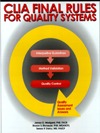CLIA Final Rule
Part V: Method Validation Process and Procedures
Final5 CLIA Rule. Part V:
Method Validation Process and Procedures
Starting on April 24, 2003, all non-waived laboratory methods must be validated. This includes methods that were previously exempted from validation. In light of these new responsibilities, Dr. Westgard reviews the process and procedures of method validation. Learn what experiments to perform, with how much data, and in what order. (preview)
April 24, 2003
- A review of the MV process
- Applications with published data
- Applications in your own laboratory
- Adaptations for individual laboratories
- References
Laboratories will have to gear up to perform method validation studies for all "non-waived" methods implemented after April 24, 2003. That's the day we first posted this article.
The Final CLIA Rule requires that moderate complexity methods be treated the same as high complexity methods, now grouped together as non-waived methods. That means method validation studies must now be performed for many methods that were previously exempted.
A review of the MV process
Here's a brief summary of our lessons on method validation. You can access each lesson via the link provided to review the material in greater detail.
- Method Validation should be a standard laboratory process, but the process need not be exactly the same for every laboratory or for every method validated by a laboratory. See MV - The Management of Quality for an overview of the quality management process that is needed in healthcare laboratories and the role of method validation in establishing standard testing processes.
- Remember the purpose of method validation is error assessment. See MV - The Inner, Hidden, Deeper, Secret Meaning for a description of random, systematic, and total analytical errors that are the focus of method validation studies.
- Note that a USA laboratory is required by CLIA regulations to "demonstrate that prior to reporting patient test results, it can obtain the performance specifications for accuracy, precision, and reportable range of patient test results, comparable to those established by the manufacturer. The laboratory must also verify that the manufacturer's reference range is appropriate for the laboratory's patient population." For modified methods or high complexity methods, CLIA also requires verification of analytical sensitivity and analytical specificity. See MV - The Regulations.
- Other critical method factors or characteristics, such as cost/test, specimen types, specimen volumes, time required for analysis, rate of analysis, equipment required, personnel required, efficiency, safety, etc., must be considered during the selection of the analytical method. See MV - Selecting a Method to Validate.
- The approach in method validation is to perform a series of experiments designed to estimate certain types of analytical errors, e.g., a linearity experiment to determine reportable range, a replication experiment to estimate imprecision or random error, a comparison of methods experiment to estimate inaccuracy or systematic error, or interference and recovery experiments to specifically estimate constant and proportional systematic errors (analytical specificity), and a detection limit experiment to characterize analytical sensitivity. See MV - The Experimental Plan. For details of the different types of experiments, see the following:
- MV - The Linearity or Reportable Range Experiment. A minimum of 5 specimens with known or assigned values should be analyzed in triplicate to assess the reportable range.
- MV - The Replication Experiment. A minimum of 20 replicate determinations on at least two levels of control materials are recommended to estimate the imprecision or random error of the method.
- MV - The Comparison of Methods Experiment. A minimum of 40 patient specimens should be analyzed by the new method (test method) and an established method (comparison method) to estimate the inaccuracy or systematic error of the method.
- MV - The Interference and Recovery Experiments. Common interferences, such as lipemia, hemolysis, and elevated bilirubin are usually tested, along with potential interferences that are specific to the test and methodology. Recovery experiments are used to test competitive interferences, such as the possible effects of proteins and metabolics in the specimens.
- MV - The Detection Limit Experiment. Generally, a "blank" specimen and a specimen "spiked" with the amount of analyte in the manufacturer's claim for the limit of detection are each analyzed 20 times.
- The data collected in the different experiments needs to be summarized (by statistical calculations) to provide estimates of the analytical errors that are the focus of each experiment. See MV - The Data Analysis Tool Kit.
- The acceptability of these observed errors is judged by comparison to standards of quality, i.e., recommendations for the types and amounts of analytical errors that are allowable without invalidating the medical usefulness of the test results. Method performance is acceptable when the observed errors are smaller than the stated limits of allowable errors. Method performance is not acceptable when the observed errors are larger than the stated limits of allowable errors. For a quality standard in the form of an allowable total error (such as provided by the CLIA proficiency testing criteria for acceptable performance), a simple graphical tool - the Method Decision Chart - can be constructed to classify method performance as excellent, good, marginal, or unacceptable [1]. See MV - The Decision on Method Performance.
- If method performance is judged acceptable, the reference intervals should be verified. See MV - Reference Interval Transference
 Want to read the rest of this article?
Want to read the rest of this article?
We invite you to purchase the CLIA Final Rules manual, available through the online store. You can download the Table of Contents and a preview chapter for free.
